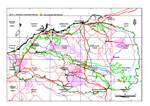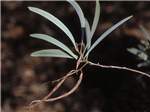Click on images
to enlarge



Photographer: J. Maslin

Photographer: M.W. McDonald

Photographer: B.R. Maslin

Photographer: B.R. Maslin

Photographer: B.R. Maslin

Photographer: B.R. Maslin

Photographer: J. Maslin

Photographer: J. Maslin
, BRM 8712, lab photo by Fiona McCallum ADJUSTED_sml.jpg)
Seed from one herbarium voucher. Scale in mm. Photographer: F. McCallum.
Botanical name
Acacia distans Maslin, Nuytsia 4: 386, figs 3, 4 & 14 (1983)
Common name
Manggurda Wattle
Description
Shapely trees 4-10 (-12) m tall, commonly ±umbrella-shaped, with a single, usually straight (sometimes slightly crooked) trunk or divided at or near ground level into a few trunks (to about 5), trunks commonly 15-20 cm diameter at breast height but on the oldest plants may attain a basal diameter of 40-50 cm, the silvery grey-green crowns rather dense and commonly occupying the upper ¼-1/3 of the plant height, Pilbara plants may sometimes develop rounded crowns that extend to near ground level. Bark black to dark grey or dark brown, longitudinally fissured on main trunks, smooth on branches. Branchlets slender, glabrous. New shoots densely sericeous with yellow hairs at first, the indumentum aging white rendering the phyllodes a silvery green colour. Phyllodes falcate (i.e. recurved and broadest at the middle and narrowed at both ends), 6-10 (-15) cm long, 4-11 mm wide, thinly coriaceous, wide-spreading or sub-pendulous, not rigid, densely appressed-hairy when young but indumentum sparser with age, silvery grey-blue, silvery grey-green or silvery green; parallel longitudinal nerves numerous, fine and close together, the central one slightly more evident than the rest; the apex acute and not spiny. Inflorescences superficially simple but normally comprising rudimentary 2-headed racemes with axes 0.5-2 mm long; peduncles (4-) 8-12 mm long, minutely appressed-hairy, sometimes glabrous when in pod; spikes lightly fragrant, 3-7 (-11) cm long, golden, interrupted with the small flowers loosely arranged in widely-spaced clusters along the receptacle. Flowers 5-merous; calyx small, 1/5-1/6 length of petals, dissected for about ½ its length into broadly triangular lobes. Pods linear to sub-moniliform (i.e. ±slightly raised over seeds and usually shallowly constricted between them), 4-14 cm long, width variable, 3-6 (-7) mm wide, thin-crustaceous, straight to shallowly curved, finely longitudinally nerved, brown or grey-brown but often silvery due to dense covering of minute, appressed hairs. Seeds longitudinal in the pods, ellipsoid, 4-7 mm long, ±shiny, brown (sometimes tinged greenish grey) except sometimes obscurely dull yellow near the central; aril small and white or cream.
Characteristic features
Shapely trees with silvery grey-blue or grey-green crowns that often form pure stands. New shoots hairy but mature branchlets glabrous. Phyllodes falcate, wide-spreading, finely longitudinally multi-nerved. Spikes very long (mostly 3-7 cm), with the small flowers loosely arranged in widely-spaced clusters. Pods linear to sub-moniliform, long and narrow (4-14 cm x 3-6 mm), thin-textured.
Distribution and ecology
Occurs mainly between the Murchison and Ashburton rivers in W.A. However, it does extend to the Pilbara where it has a scattered distribution, mostly on the floodplain of the Fortescue River where it is most common in the vicinity of Munjina and Mulga Downs Station; it also occurs to the northeast of Newman along tributaries of the Fortescue River such as Jigalong Creek on Ethel Creek and Roy Hill Stations. The Pilbara plants grow on loam, clay or sandy clay and forms large, dense, pure stands. Doran and Turnbull (1997) provide additional ecological information concerning the species.
Flowering and fruiting period
Flowers from late March to May or occasionally June. Mature pods occur mainly in September and October.
Affinities
In the field A. distans may easily be mistaken for A. citrinoviridis because these two species have a similar growth form and phyllode morphology, yellow-sericeous new shoots and are found in similar riverine habitats. Acacia citrinoviridis , however, is distinguished by having shorter inflorescence spikes (8-32 mm long) with the flowers much closer together (not in arranged in widely-spaced clusters as in A. distans) and inserted on a densely yellow-hairy receptacle, and its broader, often yellow-hairy pods. Acacia citrinoviridis also tends to favor sandier soil types along drainage feature whereas A. distans always occurs on heavy soils which a high water holding capacity. Acacia distans may also superficially resemble some individuals of A. catenulata subsp. occidentalis (see that subspecies for discussion).
Notes
Field observations suggest that A. distans is moderately fast-growing and is long-lived. It is likely to be poorly adapted to acid soils.
The moderately dense wood of this species would make an excellent fuel and the dark brown, hard heartwood has potential for conversion into small decorative craft wood items.
The species has some potential for shelter, shade and soil protection; it would be well-suited to amenity planting on account of its attractive growth form, dark coloured trunks and silvery crowns.
The above information is taken from Doran and Turnbull (1997).
The recommended seed germination pretreatment is boiling water and let stand for 24 hours before planting (Gunn 1990). Supplementary watering during the first year may be required for successful establishment in arid and semi-arid regions (Doran and Turnbull 1997).
Conservation status
Not considered rare or endangered.
Origin of name
The botanical name is derived from the Latin distans (standing apart) in reference to the spikes having well-spaced flowers. The common name Manggurdu Wattle is from the Banyjima name for the Fortescue River and thus reflects the Pilbara distribution of A. distans which is entirely restricted to the Fortescue River catchment. The Banyjima people are the traditional owners of the lands in the central Pilbara centered on the settlements of Wittenoom and Munjina and capturing the northern sections of Karijini National Park.
References
Doran, J.C. and Turnbull, J.W. (1997). Australian trees and shrubs: species for land rehabilitation and farm planting in the tropics. ACIAR Monograph No. 24. pp. 384. (Australian Centre for International Agricultural Research: Canberra.)
Gunn, B.V. (1990). Germination pretreatments for selected Acacia species from the Pilbara region of Western Australia. pp. 46-50. In: J.W. Turnbull (ed.) Tropical Tree Seed Research. pp. 156. ACIAR Proceedings No. 28. (Australian Centre for International Agricultural Research: Canberra.)
